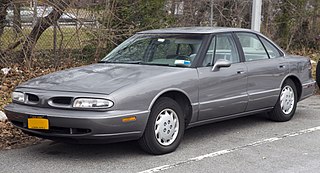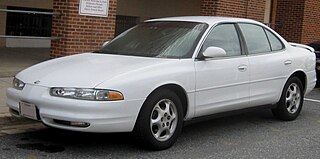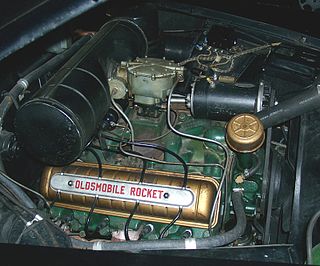Related Research Articles

Oldsmobile was a brand of American automobiles, produced for most of its existence by General Motors. Originally established as "Olds Motor Vehicle Company" by Ransom E. Olds in 1897, it produced over 35 million vehicles, including at least 14 million built at its Lansing, Michigan factory alone.

The Oldsmobile Cutlass was a series of automobiles produced by General Motors' Oldsmobile division between 1961 and 1999. At its introduction, the Cutlass was Oldsmobile's entry-level model; it began as a unibody compact car, but saw its greatest success as a body-on-frame intermediate. The Cutlass was named after Vought F7U Cutlass, as well as the type of sword, which was common during the Age of Sail.

The Oldsmobile 98 is the full-size flagship model of Oldsmobile that was produced from 1940 until 1942, and then from 1946 to 1996. The name – reflecting a "Series 90" fitted with an 8-cylinder engine – first appeared in 1941 and was used again after American consumer automobile production resumed post-World War II. It was, as it would remain, the division's top-of-the-line model, with lesser Oldsmobiles having lower numbers such as the A-body 66 and 68, and the B-body 76 and 78. The Series 60 was retired in 1949, the same year the Oldsmobile 78 was replaced by the 88. The Oldsmobile 76 was retired after 1950. This left the two remaining number-names to carry on into the 1990s as the bread and butter of the full-size Oldsmobile lineup until the Eighty Eight-based Regency replaced the 98 in 1997.

The Oldsmobile 88 is a full-size car that was sold and produced by Oldsmobile from 1949 until 1999. From 1950 until 1974, the 88 was the division's most profitable line, particularly the entry level models such as the 88 and Dynamic 88. The 88 series was also an image leader for Oldsmobile, particularly in the early years (1949–51), when it was one of the best performing automobiles, thanks to its relatively small size, light weight, and advanced overhead-valve high-compression V8 engine. This engine, originally designed for the larger C-bodied and more luxurious 98 series, also replaced the straight-8 on the smaller B-bodied 78. With the large, high performance V8, the Oldsmobile 88 is considered by some to be the first muscle car, although this title is disputed.

The Oldsmobile Toronado is a personal luxury car manufactured and marketed by the Oldsmobile division of General Motors from 1966 to 1992 over four generations. The Toronado was noted for its transaxle version of GM's Turbo-Hydramatic transmission, making it the first U.S.-produced front-wheel drive automobile since the demise of the Cord 810/812 in 1937.

The Oldsmobile Intrigue is a mid-size sedan that was manufactured from 1997 through 2002 by Oldsmobile. The Intrigue's design cues were first seen in 1995 with the Oldsmobile Antares concept car, being unveiled in production form in January 1996 at the North American International Auto Show. The Intrigue was the first casualty in the three-year phase-out process of Oldsmobile; Olds' remaining models would last an additional year or two.

The Oldsmobile Aurora is a luxury sedan, manufactured and marketed by General Motors from 1994 until 2003 over two generations — sharing platforms with Buick Riviera and using the Cadillac-derived G platform. At the time of production, the Aurora was the flagship vehicle in the Oldsmobile lineup. It originated as the 1989 Oldsmobile tube car concept.

The Oldsmobile Cutlass Supreme is a mid-size car produced by Oldsmobile between 1966 and 1997. It was positioned as a premium offering at the top of the Cutlass range. It began as a trim package, developed its own roofline, and rose during the mid-1970s to become not only the most popular Oldsmobile but the highest selling model in its class.

In automotive design, a front-engine, front-wheel-drive (FWD) layout, or FF layout, places both the internal combustion engine and driven roadwheels at the front of the vehicle.

The Oldsmobile 4-4-2 is a muscle car produced by Oldsmobile between the 1964 and 1987 model years. Introduced as an option package for US-sold F-85 and Cutlass models, it became a model in its own right from 1968 to 1971, spawned the Hurst/Olds in 1968, then reverted to an option through the mid-1970s. The name was revived in the 1980s on the rear-wheel drive Cutlass Supreme and early 1990s as an option package for the new front-wheel drive Cutlass Calais.

The Buick V6 is an OHV V6 engine developed by the Buick division of General Motors and first introduced in 1962. The engine was originally 198 cu in (3.2 L) and was marketed as the Fireball engine. GM continued to develop and refine the 3.8 L (230 cu in) V6, eventually and commonly referred to simply as the 3800, through numerous iterations.

The Shelby Mustang is a high-performance variant of the Ford Mustang built by Shelby American from 1965 to 1967 and by the Ford Motor Company from 1968 to 1970.

The Oldsmobile V8, also referred to as the Rocket, is a series of engines that was produced by Oldsmobile from 1949 until 1990. The Rocket, along with the 1949 Cadillac V8, were the first post-war OHV crossflow cylinder head V8 engines produced by General Motors. Like all other GM divisions, Olds continued building its own V8 engine family for decades, adopting the corporate Chevrolet 350 small-block and Cadillac Northstar engine only in the 1990s. All Oldsmobile V8s were manufactured at plants in Lansing, Michigan while the engine block and cylinder heads were cast at Saginaw Metal Casting Operations.

The General Motors E platform or E-body was the automobile platform designation used for a number of personal luxury cars produced from 1963 to 2002. Notably, early E-bodies were produced in both front wheel drive and rear wheel drive configurations, and were the first front wheel drive automobiles produced in the United States since 1937. The initial front-wheel drive E-platform power plant was referred to as the Unitized Power Package (UPP).

Following the success of Hurst components in Oldsmobile's 442 models, Oldsmobile, in collaboration with Hurst Performance of Warminster, Pennsylvania, produced special-edition performance versions of the 442 or Cutlass Supreme, the Hurst/Olds.

The GMC Motorhome is a recreational vehicle that was manufactured by the GMC Truck & Coach Division of General Motors for model years 1973–1978 in Pontiac, Michigan, USA — as the only complete motorhome built by a major auto/truck manufacturer. Manufactured in 23 and 26 ft lengths, the design was noted for its front-wheel drive and its low profile, fully integrated body.

In automotive engineering, a longitudinal engine is an internal combustion engine in which the crankshaft is oriented along the long axis of the vehicle, from front to back.
The following outline is provided as an overview of and topical guide to automobiles:

Kelmark Engineering was an American automotive specialty shop established in 1969 and based in Okemos, Michigan. It focused on high-performance custom V8 drivetrain swaps, the modification and production of rear and mid-engined cars, and custom-built turn-key automobiles. Until 1986, Kelmark Engineering manufactured kits and complete, finished, turn-key vehicles which were either Volkswagen-based or built on tubular race car-type frames. The outfit gained its name from Russ Keller and Randy Markham, the two co-creators who started the operation. Up until at least 1989, the Kelmark GT was still available as a kit albeit the manufacturer was Kelmark Motors in Holt, Michigan. The cars are all "rare" models, but the Volkswagen-powered Kelmark GT was the most popular.
Billy Lewis "Wild Bill" Shrewsberry is an American exhibition drag racing driver primarily active throughout the 1960s and 1970s. Originally from Mansfield, Ohio, Shrewsberry moved to Southern California in October 1962. Shrewsberry is best known as the driver of the drag racing replica of the Barris-built Batmobile from the 1966 television series and of the "L.A. Dart," a series of wheelstanding funny cars each with a rear-mounted, supercharged Chrysler Hemi engine and each sponsored by the Dodge and Plymouth dealers of Los Angeles and Orange Counties. The result of the rearward weight transfer caused by the engine's mounting position was a "wheelie" for the entire quarter-mile at speeds exceeding 100 miles per hour (160 km/h). Steering was accomplished by a combination of the service brake pedal activating the brake on the left wheel while a brake lever from a racing go-kart activated the right brake. So proficient was Shrewsberry at this sort of driving that he would often spin his car to face the opposite direction at the end of the track and race back to the starting line, all the while maintaining the wheelstand.
References
- ↑ https://web.archive.org/web/20110818042120/http://hursthairyolds.com/default.aspx Archived fan-site
- ↑ https://www.flickr.com/photos/joeross/2253373939/ Present day photo of the 1966 car on museum display at Flickr.com